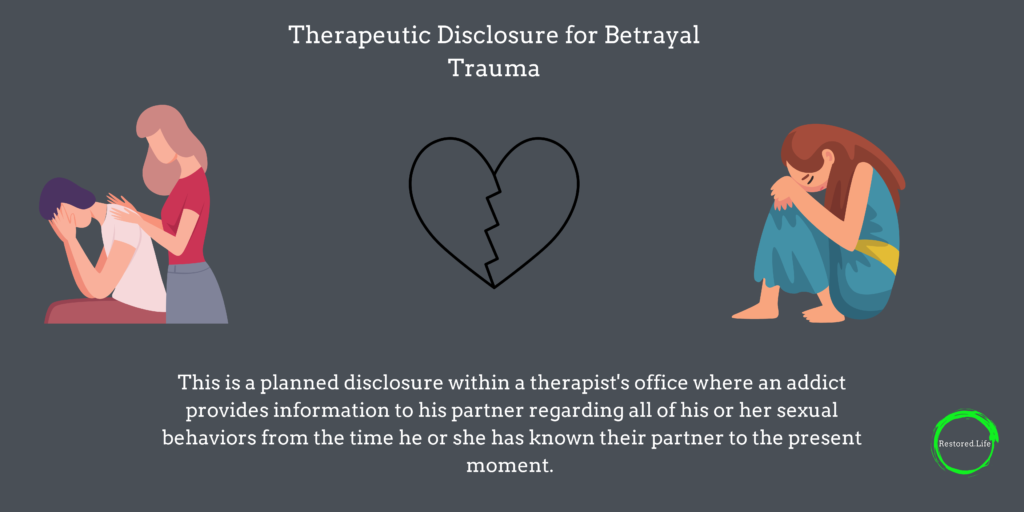How much detail should therapeutic disclosure include?
Details should include:
- Type of acting out behavior
- Frequency of behaviors
- A general timeline of behaviors
- Number of partners
- Estimate money spent
- Alibis used to cover up behaviors
When should therapeutic disclosure happen?
Typically within three to six months after the beginning of treatment is when therapeutic disclosure occurs between couples. This may seem like a long time to wait for disclosure to happen, especially for the betrayed partner. However, rushing disclosure is very harmful. The partner in recovery must build a strong foundation of honesty, accountability, and support before he or she can be successful during disclosure. This process is slower than most partners want, but necessary to prevent further harm.
What is the purpose of disclosure?
Facilitated full disclosure gives the betrayed partner an opportunity to know what they need to know in order to make a choice about the relationship, rather than being manipulated into staying. It also gives the betrayer an opportunity to put an end to his or her double life – which is scary before it’s done, but brings immense relief after it’s done.
What is a staggered disclosure?
When the betrayed partner receives repeated and incomplete information about the betrayer’s actions, either directly or indirectly.
What are the benefits of disclosure in betrayal trauma therapy?
- Restored truth
- Confrontation of deception
- Hope for a future relationship
- Betraying spouse able to get free from shame and secrets
- Betrayed spouse is empowered to make informed choices about the future
What are the risks of disclosure in betrayal trauma therapy?
- Temporarily increased shame and guilt
- Temporary separation or divorce
- Financial, legal, or professional consequences
- Changes in family functions
- Loss of trust
What are the steps in telling the truth?
This acronym may be helpful: ACT.
Awareness: Betrayed partner is given information about the other partner’s sexual behaviors.
Coming clean: Betraying partner has a chance to give full disclosure of the sexual behaviors they have engaged in.
Truth: Bringing in truth is the best chance at building the relationship upon restored trust.

What type of mental health professionals use therapeutic disclosure for betrayal trauma?
For best results, therapeutic disclosure should be facilitated by therapists trained by the International Institute of Trauma and Addiction Professionals (IITAP), with any of the following specialties:
- Certified Sex Addiction Therapist (CSAT)
- Certified Partner Trauma Therapist (CPTT)
- Pastoral Sex Addiction Professional (PSAP)
What types of betrayal trauma are there?
- Partner betrayal – Through sexual betrayal, sexual addiction, substance addiction, sexual infidelity, sexual behavior, porn addiction, and other forms.
- Child abuse – Through physical abuse, sexual abuse, and emotional abuse.
What is the healing process after betrayal trauma?
- Acknowledgement instead of avoidance
- Practice accepting difficult emotions
- Turn to others for support
- Focus on what you need
- Rebuilding relationship trust
Why would anyone want a therapeutic full disclosure?
Both parties have been surveyed, and research tells us that it was the right course of action to take after going through the disclosure process. 96% of betrayers and 93% of betrayed partners felt that it was in their best interest.
What is disclosure?
The other partner can see the truth transparently and fully. All of the facts are laid out on the table.
When it comes to partner abuse, what other forms of betrayal are there?
If there is one form of abuse occurring, the chances increase that other forms are also occurring. These may be any combination of:
- Sexual abuse
- Emotional abuse
- Financial abuse
- Spiritual abuse
- Mental abuse
- Physical abuse
Can you get closure after no longer being in the relationship with the betrayer?
Yes, you can. Grief and forgiveness are both messy, painful, and necessary in order to achieve closure. Some who have experienced betrayal also benefit from writing and sharing their testimony or survivor story.
How accurate are lie detector tests? Are they helpful in the healing process with disclosure?
There is about an 80% rate of accuracy in polygraph testing. – at least, according to polygraph examiners. Polygraphs are very controversial. In theory, they detect lying because lying causes a physiological disturbance of some kind. However, false positives for lying are common because strong emotions of any sort cause the same physiological disturbances that may indicate lying. It may be very unreasonable to expect a betrayer to be able to remain completely emotionally calm while taking a polygraph. Most US states do not allow evidence from polygraph examinations to be used in court for criminal proceedings.
What are some boundaries to follow while you or your partner is in recovery?
- Allocate time, energy, and money toward personal healing
- Abstain from sex for a specified period of time
- Detach from abusive and manipulative conversations
- Sleep or live in separate parts of the house
- Explore temporary separation if needed
- Choose to limit or eliminate all contact for a period of time if needed.
What are some recommended books for betrayal trauma?
- Healing Betrayal: First Steps for Partners and Spouses of Sex and Pornography Addicts – Mari Lee
- Facing Heartbreak: Steps to Recovery for Partners of Sex Addicts – Stephanie Carnes and Mari Lee
- Help Her Heal: An Empathy Workbook for Sex Addicts to Help their Partners Heal – Carol Jergensen Sheets
- Boundaries – Dr. Henry Cloud and Dr. JohnTownsend
- The Body Keeps the Score – Bessel Van Der Kolk, M.D.
- Your Brain on Porn – Gary Wilson
- The Seven Principles for Making Marriage Work – John M. Gottman, Ph.D.
